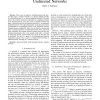Free Online Productivity Tools
i2Speak
i2Symbol
i2OCR
iTex2Img
iWeb2Print
iWeb2Shot
i2Type
iPdf2Split
iPdf2Merge
i2Bopomofo
i2Arabic
i2Style
i2Image
i2PDF
iLatex2Rtf
Sci2ools
CORR
2008
Springer
2008
Springer
Mapping Semantic Networks to Undirected Networks
Abstract--There exists an injective, information-preserving function that maps a semantic network (i.e a directed labeled network) to a directed network (i.e. a directed unlabeled network). The edge label in the semantic network is represented as a topological feature of the directed network. Also, there exists an injective function that maps a directed network to an undirected network (i.e. an undirected unlabeled network). The edge directionality in the directed network is represented as a topological feature of the undirected network. Through function composition, there exists an injective function that maps a semantic network to an undirected network. Thus, aside from space constraints, the semantic network construct does not have any modeling functionality that is not possible with either a directed or undirected network representation. Two proofs of this idea will be presented. The first is a proof of the aforementioned function composition concept. The second is a simpler proof ...
| Added | 09 Dec 2010 |
| Updated | 09 Dec 2010 |
| Type | Journal |
| Year | 2008 |
| Where | CORR |
| Authors | Marko A. Rodriguez |
Comments (0)

